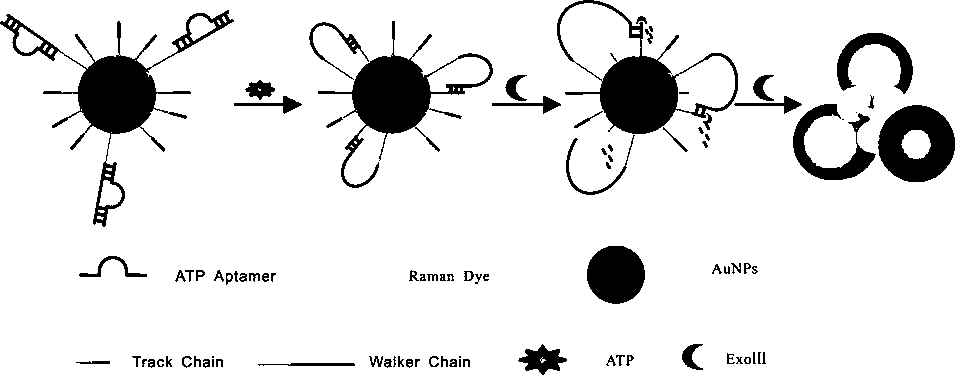Biosensor for detecting ATP activity and preparation method and application thereof
A biosensor and active technology, applied in the field of biosensors, can solve the problems of photobleaching by fluorescence method and poor sensitivity of colorimetric method, and achieve the effects of high sensitivity, improving signal-to-background ratio, and avoiding fluorescent photobleaching.
- Summary
- Abstract
- Description
- Claims
- Application Information
AI Technical Summary
Problems solved by technology
Method used
Image
Examples
Embodiment 1
[0037] Example 1 Pure ATP Concentration Detection
[0038] 1. Modification of Raman dyes and nucleic acid strands to the surface of gold nanoparticles:
[0039] a. Take 1 mL nano-gold solution in a centrifuge tube, centrifuge for 10 min, and centrifuge the two tubes at the same time for later use. Centrifuge until the supernatant is colorless and transparent, remove the supernatant, and add 300 μL of sterile water to concentrate the nano-gold solution to 3 nM. Transfer to a 1 mL glass vial, seal it with tinfoil, and add 12 ul of Raman dye (4-NTP) with a concentration of 0.25 nM.
[0040] b. After standing at room temperature for 30 minutes, add 150 μL (the concentration ratio of Walker Chain / Protect Chain hybridization solution to Track Chain is 20:1) 30 μM nucleic acid chain modified with -SH, mix well, and place at 4 °C for 24 h.
[0041] c. Slowly add 50 μL of PBS buffer several times, add magnets (soaked in aqua regia the day before) and stir for 10 min, then continue t...
Embodiment 2
[0046] Embodiment 2 The present invention detects the sensitivity of ATP method
[0047] 1. Modification of Raman dyes and nucleic acid strands to the surface of gold nanoparticles:
[0048] Same as in Example 1, the reaction substrate is still the above-mentioned gold nanoparticle solution labeled with nucleic acid.
[0049] 2. Sensitive detection in homogeneous solution
[0050] Add 2 uL of (ATP / ADP / GTP / CTP) solution containing 2 uL of exonuclease III (2 U / mL), 2 uL of 10×Buffer (10 mM Tris-HCl, 50 μM NaCl, 10 mM MgCl 2 , 1 mM DTT, pH 7.9), 10 uL of gold nanoparticles solution modified with nucleic acid strands and Raman dye (add water to make up to 20 uL reaction system), another blank control sample (blank); shake for 30 s, put Into a 37 °C water bath for 60 min.
[0051] After 60 min, the mixed solution was taken out from the water bath, the color change was observed, and detected by a Raman spectrometer to obtain the SERS spectrum of each group of samples. From the r...
PUM
 Login to View More
Login to View More Abstract
Description
Claims
Application Information
 Login to View More
Login to View More - R&D
- Intellectual Property
- Life Sciences
- Materials
- Tech Scout
- Unparalleled Data Quality
- Higher Quality Content
- 60% Fewer Hallucinations
Browse by: Latest US Patents, China's latest patents, Technical Efficacy Thesaurus, Application Domain, Technology Topic, Popular Technical Reports.
© 2025 PatSnap. All rights reserved.Legal|Privacy policy|Modern Slavery Act Transparency Statement|Sitemap|About US| Contact US: help@patsnap.com



